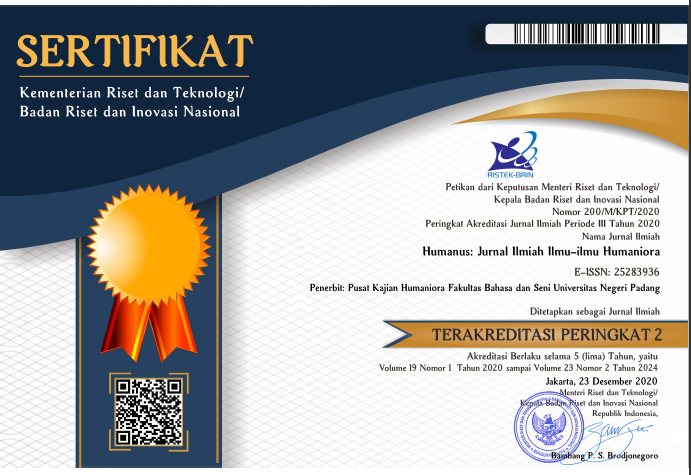ECRANISATION, FROM TEXTUAL TRADITION TO CINEMA: THE INFIDELITY AGAINST THE VALUES OF LITERARY WRITING?
 ),
), (1) Universitas Sebelas Maret of Surakarta, Faculty of Cultural Sciences
 Corresponding Author
Corresponding Author
Copyright (c) 2017 Humanus
DOI : https://doi.org/10.24036/humanus.v16i1.7961
Full Text:
 Language : en
Language : en
Abstract
EKRANISASI, DARI TRADISI TEKSTUAL KE SINEMA: KETIDAKSETIAAN TERHADAP NILAI-NILAI-NILAI DALAM SASTRA TULIS?
Abstract
Ecranization is a wide-screening or transferring process of a novel into the movie. Ecranization can be a process of sifting or transferring or removing characteristics of a novel into a film. This study is written descriptive-qualitatively based on data collected from the results of literature studies. The data include primary and secondary data. Primary data covers the novel of Ayat-Ayat Cinta published by PT Penerbit Republika-Basmala in 2005 which is also a material object, some quotes or dialogues in Ayat-Ayat Cinta (AAC) by Habiburahman El Shirazy and the AAC film directed by Hanung Bramantyo. The study found that despite the fact both the title of the film and the names of the main characters are the same as the novel, but the rides from novel to film have separated and distinguished the distinctive features of the media itself with their respective rides, novel vehicles and movie rides. We can neither expect the loyalty of a film to the novel as the source of the story because there will certainly occur changes following the nature of the media and their respective lovers. It is important to emphasize that in distinguishing how to enjoy two different mediums it is necessary to appreciate the works of literature to avoid disappointment because of the natural differences that must exist between the film and the novel.
Keywords: Ayat-Ayat Cinta, difference, ecranization, film, novel, media
Abstrak
Ekranisasi adalah proses pemutaran film layar lebar atau transfer sebuah karya novel ke dalam bentuk film. Ekranisasi merupakan proses penyaringan atau pemindahan karakteristik novel ke dalam sebuah film. Penelitian ini ditulis secara deskriptif-kualitatif berdasarkan data yang dikumpulkan dari hasil studi kepustakaan. Data meliputi data primer dan data sekunder. Data primer mencakup novel Ayat-Ayat Cinta yang diterbitkan oleh PT Penerbit Republika-Basmala pada tahun 2005 yang juga merupakan objek material, beberapa kutipan atau dialog dalam Ayat-Ayat Cinta (AAC) oleh Habiburahman El Shirazy dan film AAC yang disutradarai oleh Hanung Bramantyo. Kajian ini menemukan bahwa kendati judul film dan nama-nama tokoh utama dalam film AAC sama dengan novelnya, namun wahana dari novel ke film telah memisahkan dan membedakan ciri khas media itu sendiri dengan wahana masing-masing. Terkait wahana yang harus diciptakan, kita memang tidak bisa mengharapkan kesetiaan film terhadap novel sebagai sumber ceritanya, karena pasti akan terjadi perubahan mengikuti sifat media dan pecinta karya sastra film tersebut. Penting untuk ditekankan bahwa dalam membedakan bagaimana menikmati dua media yang berbeda tersebut diperlukan apresiasi terhadap karya-karya sastra untuk menghindari kekecewaan karena perbedaan alamiah yang harus ada antara film dan novel.
Kata Kunci: Ayat-Ayat Cinta, perbedaan, ekranisasi, film, novel, media
Keywords
References
Alfian, T.I. (1992). Dari Babad Sampai Sejarah Kritis. UGM Press, Yogyakarta
Bluestone, G. (1957). Novels into Film. Berkeley, Los Angeles, London: University of California.
El-Shirazy, H. (2005). Ayat Ayat Cinta. Jakarta: Penerbit Republika-Basmala.
El-Shirazy, H. (2007). Ketika Cinta Bertasbih. Jakarta: Republika-Basmala.
Eneste, P. (1991). Novel dan Film. Flores: Nusa Indah.
(al-)Habib Alwi, H. (2007). Sejarah Masuknya Islam di Timur Jauh. Lentera, Jakarta.
Istadiyantha & Wati, R. (2015). “Ekranisasi: Adaptasi Karya Sastra ke Film”. Seminar Nasional PIBSI (Pekan Ilmiah Bahasa dan Sastra Indonesia) XXXVII, 2-3 Oktober 2015. Yogyakarta: Universitas Sanata Dharma
Jauss, Hans Robert. (1982). Aesthetic and Literary Hermeneutics. Minneapolis: University of Minnesota Press.
Karkono. (2009). Perbedaan novel dan film,Ekranisasi,Strukturalisme dinamik,Teori resepsi. Tesis. Yogyakarta: Universitas Gadjah Mada
Liasna, T., Ansari, K. (2016). Gender Perspective In the Novels Padang Bulan And Cinta Di Dalam Gelas by Andrea Hirata: A Study of Structure and Feminism Literary Criticism and Its Relevance as the Literature Reading Materials for High Schools, Humanus: Jurnal Ilmiah Ilmu-ilmu Humaniora, 15, (2), 2016. DOI: 10.24036/jh.v15i2.6587
Manaf, N.A. (2015). Dinamika Penggunaan Kata Dan Istilah Dalam Karya Sastra Indonesia dan Implikaturnya, Humanus: Jurnal Ilmiah Ilmu-ilmu Humaniora, 14, (1), 2015, DOI: 10.24036/jh.v14i1.5406
Muhammad, S. (2004). Kesultanan Ternate, Sejarah Sosial Ekonomi & Politik. Ombak, Yogyakarta
Wati, R. (2014). Emak Ingin Naik Haji: Kajian Ekranisasi. Program Pascasarjana Universitas Gadjah Mada.
Woflgang, I. (1978). The Act of Reading: A Theory of Aesthetic Response. London: The Johns Hopkins University Press.
Woolford, D. (1976). Papua New Guinea: Initation and independence. Queensland: University of Queensland Press.
 Article Metrics
Article Metrics
 Abstract Views : 1100 times
Abstract Views : 1100 times
 PDF Downloaded : 337 times
PDF Downloaded : 337 times
Refbacks
- There are currently no refbacks.
Copyright (c) 2017 Humanus

This work is licensed under a Creative Commons Attribution-NonCommercial 4.0 International License.










